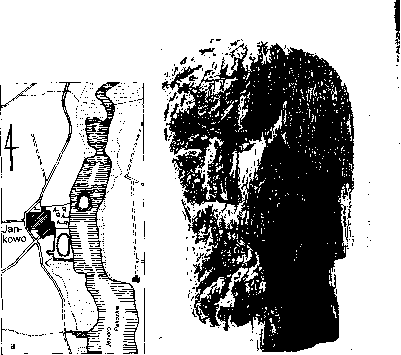image104


Fig. 86. Jankowo. a: The location (after W. Hensel, 1953, p. 188). b: A wooden sculpture of małe head (after M. Gozdowski, 1951, p. 153).
We know several stone figures from Polabia. First, there is a granitc piąte sized 1.19 x 1.68 m, incorporated into the thirteenth-century wali of the vestry of the church in Altenkirchen. The relief on the piąte represents a man with moustache, wearing a long robę, with a large hora in his hands. As David Chytreus (1586, p. 35) testifies, already in 1586 the piąte was in its present place and was called Jaromirstein (Jaromir’s stone). The interpreta-tion of this relic as a primitive Christian gravestone - possibly from the grave of Tetislav, Jaromir’s brother, baptized in 1168 (Holtz, 1966, p. 20) - is unconvincing. The way in which the piąte is set in the wali depreciates the represented figurę, which is situated upside down. The relief lacks any Christian symbols, while the large hora, Sventovit’s attribute, stands out very clearly. Following a local legend, David Chytreus interpreted the Alten-kirchen piąte as an effigy of Sventovit. In the 18thc. the relief was accom-panied with painted words: “Sanctus Vitus oder Svantevit" which is now hardly visible. This tradition survived in the folk culture until the 19thc. (Haas, 1896, p. 7).
Another piąte of similar size is built into the exterior surface of the wali of the Holy Virgin’s church in Bergen. It shows a man with his hands crossed on his chest, holding a cross, which, however, replaced an earlier, removed carving (Holtz, 1966, p. 10, 19).

/U*' -M .wmt

Fig. 87. Dąbrówka. A wooden. sculpture of małe head thrown ashore by the waters of the Warta river. After M. Goz-dowski, 1951, p. 150—151.
Two granite plates built into St Peter’s church in Wolgast contain not reliefs, but pic-tures, engraved in stone in a rather primitive manner, presenting human figures. One of the Stones, sized 193 x 117 cm, lies in the foundations of the late-Gothic tower and is called Gerovit’s stone (Gerovitstein). The drawing represents a man with a spear, sitting or standing on a hill.
Over his head there is a Maltese cross, which was carved later than the whole composition and effaced the spearhead. A similar stone (84x44 cm) is situated in the passage around the church choir; it shows a man with a spear, wearing a long robę with fringes. Over his head there is a cross added later (Holtz, 1966, p. 11-12; Buske, 1984, p. 30, 41). A similar drawing in stone, sized 125x66 cm, was built into the wali of St Peter’s church in Słupsk (Holtz,
1966, p. 14; SSS, vol. 5, p. 308). Another, less renowned stone with reliefs exists in Stolpe near Anklam. One side of it bears an image of a man, the other - of a cross and a hom (Holtz, 1966, p. 13; Filipowiak, 1993, p. 40).
No analogical monumental relics have been discovered in Southern Polabia, Bohemia and Slovakia. The statuę from Holzgerlingen belongs probably to Celtic culture (Schlette, 1987, p. 159), the idols from Bamberg resemble stone
“crones” (Leńczyk, 1964, p. 42), while late records concerning the statuę of Triglav from Meissen (Kirfel, 1948, p. 88; Łowmiański, 1979, p. 177) and the sculpture from Zadel (Coblenz, 1960, p. 8) are rather controversial. Polish and Pomeranian territories, besides the aforementioned engraving from Słupsk, supplied several finds. In 1856 in Leźno near Kartuzy an engraved stone reaching 80 cm in height, now kept in the Archaeological Museum in Gdańsk, was discovered. The reliefs covering three sides of it show a rider, a standing man and a man with a hom in the right hand (Lega, 1929, p. 419-421; Łuka, 1973, p. 78). Two smali statues come from Powiercie near Koło: one of them is a figurę holding a vessel or a ritual cake in front
211
Wyszukiwarka
Podobne podstrony:
image102 Fig. 82. Fischerinsel. The female figurę, a - the front view, b - the side view. After E. G
image100 Psrdwln Fig. 79. The location of Triglav’s sanctuary in Brandenburg-Brenna on Triglav’s Hil
image054 Fig. 36. Starigard (Oldenburg). The location of the stronghold; after M. Muller-Wille, 1988
Slajd50 1 Akademia medycyny i piękna o*IPL- zmiany naczyniowe Fig. 6 A Spider nevus at the nose. B A
DSC06863 L / Ryc. 86. Koncepcja zagospodarowania placu przy cmentarzu (2005) Fig. 86. Concept of man
image106 Fig. 90. Ślęża. “The Boar”. The archives of the Institute of Archaeology and Ethnology of t
image107 Fig. 102. The idols from Stavchany and the place where they were found. a - stones; b - bur
89788 image108 (8) Fig. 94. Wolgast. Gerovitstein. St Peter’s church. After Kunst und Kultur der Sla
48770 image107 (8) Fig. 92. Altenkirchen. Jaromirstein or “Svantevit”. After Kunst and Kultur der Sl
56987 image109 (8) Fig. 97. The rock frora Leźno, presently in Archeological Museum in Gdańsk. Left:
image023 Fig. 15. Korzenica-Garz. I, II, m - the alleged traces of temples in the stronghold; after
image043 Fig. 20, Wolin. The second tempie. A - the tempie, B - the yard, C - the stable, D - the pa
image047 Fig. 22. The location of the stronghold in Gross Raden. 1 - the stronghold in Gross Grónow;
więcej podobnych podstron